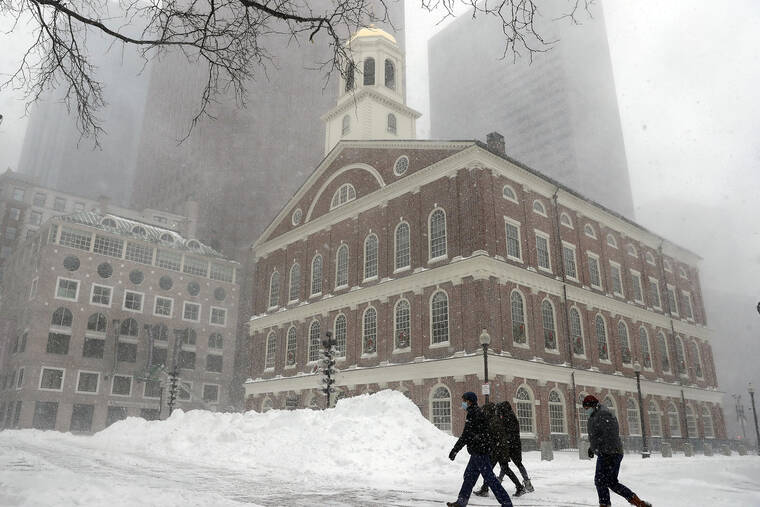Blizzard buffets East Coast with deep snow, winds, flooding
BOSTON — A nor’easter with hurricane-force wind gusts battered much of the East Coast on Saturday, flinging heavy snow that made travel treacherous or impossible, flooding coastlines, and threatening to leave bitter cold in its wake.
The storm thrashed parts of 10 states, with blizzard warnings that stretched from Virginia to Maine. Philadelphia and New York saw plenty of wind and snow, but Boston was in the crosshairs. The city could get more than 2 feet (61 centimeters) of snow by the time it moves out early Sunday.
ADVERTISING
Winds gusted as high as 83 mph (134 kph) on Cape Cod in Massachusetts. More than 22 inches (45 centimeters) of snow had fallen by midafternoon on part of Long Island in New York, while Bayville, New Jersey, had 19 inches (48 centimeters).
The wind scoured the ground bare in some spots and piled the snow into huge drifts in others.
Forecasters watched closely for new snowfall records, especially in Boston, where the heaviest snow was expected later Saturday. The Boston area’s modern snowfall record is 27.6 inches (70 centimeters), set in 2003.
New York City and Philadelphia were far from setting all-time records but still saw significant snowfall, with at least 7.5 inches (19 centimeters) in New York’s Central Park and at the Philadelphia airport.
Many flights at airports serving New York, Boston and Philadelphia were canceled Saturday, according to FlightAware. More than 4,500 flights were canceled across the U.S., though airports in the Northeast didn’t report evidence of mass strandings, given that the storm was anticipated and many airlines called off flights in advance.
Amtrak canceled all its high-speed Acela trains on the busy Boston-to-Washington corridor and canceled or limited other service.
In Boston, Dominic Torre was out driving his snow dump truck since the storm began overnight, picking up loads of plowed snow from the streets of and dumping it in unused parking lots known as “snow farms.” It was about time for such a big storm, he said.
“You know, we were overdue,” he said. “It’s pretty hairy, you know, a lot of snow. A lot of snow, a lot of trips, a lot of loads. And it ain’t over yet. It ain’t done yet.”
Videos on social media showed wind and waves battering North Weymouth, south of Boston, flooding streets with a slurry of frigid water. Other videos showed a street underwater on Nantucket and waves crashing against the windows of a building in Plymouth.
Climate change, particularly the warming ocean, probably influenced the strength of the storm, atmospheric researchers said.
Much warmer ocean waters “are certainly playing a role in the strengthening of the storm system and increased moisture available for the storm,” said University of Oklahoma meteorology professor Jason Furtado. “But it isn’t the only thing.”
The storm had two saving graces: Dry snow less capable of snapping trees and tearing down power lines, and its timing on a weekend, when schools were closed and few people were commuting.


